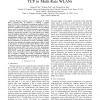Free Online Productivity Tools
i2Speak
i2Symbol
i2OCR
iTex2Img
iWeb2Print
iWeb2Shot
i2Type
iPdf2Split
iPdf2Merge
i2Bopomofo
i2Arabic
i2Style
i2Image
i2PDF
iLatex2Rtf
Sci2ools
100
Voted
INFOCOM
2007
IEEE
2007
IEEE
Cross-Layer Analysis of Rate Adaptation, DCF and TCP in Multi-Rate WLANs
—Wireless Internet access is facilitated by IEEE 802.11 WLANs that, in addition to realizing a specific form of CSMA/CA—distributed coordination function (DCF)— implement a range of performance enhancement features such as multi-rate adaptation that induce cross-layer protocol coupling. Recent works in empirical WLAN performance evaluation have shown that cross-layer interactions can be subtle, sometimes leading to unexpected outcomes. Two such instances are: significant throughput degradation (a bell-shaped throughput curve) resulting from automatic rate fallback (ARF) having difficulty distinguishing collision from channel noise, and scalable TCP performance over DCF that is able to curtail effective multiple access contention in the presence of many contending stations. The latter also mitigates the negative performance effect of ARF. In this paper, we present station-centric Markov chain models of WLAN cross-layer performance aimed at capturing complex interactions between ...
Communications | Empirical Wlan Performance | INFOCOM 2007 | Performance | Station-centric Markov Chain |
| Added | 03 Jun 2010 |
| Updated | 03 Jun 2010 |
| Type | Conference |
| Year | 2007 |
| Where | INFOCOM |
| Authors | Jaehyuk Choi, Kihong Park, Chongkwon Kim |
Comments (0)

